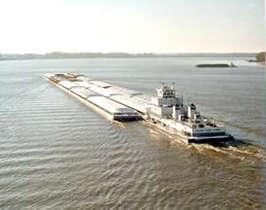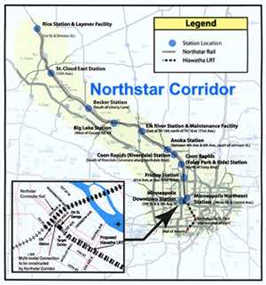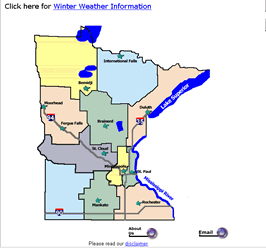 |
 |





 |
 |
 |
 |
 |
 |
Shipping season arrives on Mississippi River
|
 |
 |
 |
|
Named for Ports and
Waterway Director Dick Lambertís grandfather, the Col. George C. Lambert
towboat (above) heads south on the Mississippi River pushing barges loaded
with grain. The Mississippi River system stretches more than 231 miles
in Minnesota and supports five port areas whose combined transported cargo
in 2001 was more than 14 million tons. Photo courtesy of Ports
and Waterways Section
|
Pushing eight barges filled with fertilizer and aggregate, the towboat Reggie
G opened the 2002 Mississippi River shipping season in St. Paul on Saturday,
March 16.
The first tow arrived about a week earlier than the average and about seven
weeks earlier than last year when severe flooding delayed the start of the season,
notes Dick Lambert, Ports and Waterways Section director with Freight, Railroads
and Waterways. The 2001 season didnít begin until May 11, the latest start in
30 years.
Lambert said the mild winter and relatively thin ice on Lake Pepin that towboats
could break through unassisted contributed to the early start of the season.
An upturn in the economy, an abundance of grain to move and favorable shipping
rates, Lambert said, promise a busy shipping season on the river.
At Duluth-Superior, the first freighter will leave port tonight, Lambert said,
to carry 60,000 tons of coal to a power plant at Taconite Harbor.
The full Great Lakes shipping season begins March 25 when the locks at Sault
Sainte Marie that connect Lakes Superior and Huron open.
Click here for more information about Minnesota's
ports and waterways.
By Craig Wilkins
|
back

|
 |
Minimal changes recommended for Electronic Communications, Research Services in
Shaping Our Future effort
|
 |
 |
After reviewing the Shaping Our Future recommendations for the offices of Electronic
Communications and Research Services, the Senior Management Team March 12 determined
that limited changes be made in each of these offices.
The current functions of the Office of Electronic Communications will remain
as they currently are. Recommendations were made to improve communication and
personnel oversight in the districts in coordination with the distributed service
model.
SMT, in reviewing the Office of Research Services, agreed that the amount of
funding for research projects seems about right, but that the process should
include more direction from department management to ensure that funding of
research projects is consistent with Mn/DOT priorities.
The types and level of service provided by the Mn/DOT Library, part of the
Office of Research Services, will continue to be assessed. SMT will review the
new recommendations when the assessment is completed.
Click here for more information about Shaping
Our Future. Send questions to change@dot.state.mn.us
or to Change, Mail Stop 150.
By Sonia Pitt
|
back

|
 |
FTA approves Northstar Commuter Rail environmental impact statement; funding still
'up in the air'
|
 |
 |
 |
The proposed Northstar
Commuter rail line will run along an 82-mile route along Hwy 10 and Hwy
47 from the St. Cloud/Rice area to Minneapolis, which encompasses nearly
30 cities, townships, counties and rail authorities.
|
The proposed Northstar Commuter rail line moved one step closer to construction
March 15 when Mn/DOT received the projectís final environmental impact statement
approved and signed by the Federal Transit Administration. An FEIS documents
how a proposed project will impact social, economic and environmental resources.
"Weíre excited to reach this milestone for commuter rail. This important
approval step reinforces our belief that the Northstar Commuter Rail project
is a positive transportation choice for Minnesota," said Gov. Jesse Ventura.
The governor has requested $120 million from the Legislature to fund the stateís
share for the land acquisition, design and construction of the commuter rail
line.
"The Minnesota State Legislature must act now to fund the state portion
of this project. If not, Minnesota may be in jeopardy of losing the federal
funding that would allow this project to move to final design and construction,"
said Commissioner Elwyn Tinklenberg.
The stateís first proposed commuter rail line will run on an 82-mile route
along Hwy 10 and Hwy 47 from the St. Cloud/Rice area to Minneapolis, which encompasses
nearly 30 cities, townships, counties and rail authorities. The Northstar line
will link major economic and education centers to help support the regionís
economic vitality. Construction is anticipated to begin in late 2005, depending
on funding availability.
For more information, see Mn/DOTís
commuter rail Web page.
By Judy Jacobs and Lucy Kender
|
back

|
 |
Maintenance crews rein in second March snowstorm
|
 |
 |
 |
The TripUSA Web site
furnishes online road and weather information. According to Deb Fick,
program administrator, 26,000 users accessed the site on Mar. 14 when
the state was experienced a major snow storm. Typically, the site averages
800 to 1,000 user sessions daily.
|
March roused a once sleepy winter again March 14, sending snow accumulations
that topped more than 20 inches in some West Central and Central Minnesota locations.
Mn/DOT maintenance crews responded quickly, clearing the heavy accumulations
with dispatch.
The storm lacked the drama of the March 8 storm, which mixed rain, sleet, snow
and fierce winds that made clearing the stateís highways difficult or at times
impossible.
At Morris, Dean Olson, maintenance superintendent, said his crews did an excellent
job of getting the roads cleared quickly.
"The south end of our area got hit pretty hard, but we had it all cleaned
up by the weekend," he said.
Randy Reznicek, maintenance supervisor at St. Cloud, said his area had accumulations
of 15 to 18 inches, but he said the most difficult aspect of dealing with the
storm was cutting through compacted ice and snow on some of the areaís roads.
A section of I-94 between the St. Johnís University exit and New Munich was
closed during the stormís early hours when a semi-trailer jackknifed, blocking
both lanes. Reznicek said highway advisory signs at St. Augusta worked well
to keep motorists out of the area until maintenance crews and the State Patrol
reopened it.
Crews from St. Cloud responded to a 26-car crash on Saturday morning that occurred
in heavy fog that followed the storm.
Workers provided traffic control and spread sand to collect the fuel and other
fluids spilled in the crash on Hwy 10 near Sauk Rapids.
Heavy snow accumulations also hit the Willmar District. Jeff Butson, maintenance
supervisor at Hutchinson, said snow compacted in some areas, but generally the
storm was an easy one to handle.
"We had a lot of snow, but we had de-icing chemicals still on the roads
and the bright sunshine that followed the storm helped us a lot," he said.
Fog also hit scattered parts of the region, a result, he said, of the moisture
from the storm and the sunshine raising the dewpoint.
At Mankato, Jamie Kagel, weather reporter for KEYC-TV, rode along with snowplow
operators John Slater and Jay Spencer as they plowed following the storm.
After his experience, Kagel commended their professionalism and pride in their
work to the stationís viewers during the March 14 evening newscast.
By Craig Wilkins
|
Traveler information
available by phone or PC
Whether youíre dialing the phone or clicking a computer mouse, you
can get information about driving conditions, construction projects,
current weather and extended forecasts from Mn/DOTís traveler information
system.
"On a typical day, we receive an average of 500 to 600 calls,"
says Deb Fick, program administrator. "During the last two weekend
storms, we received an average of 10,000 to 11,000 calls."
Later this spring, Fick said callers will be able to dial 511 from
any phone and access information by geographic region, road segment
or mileage marker. Right now cell phone users (except Verizon users)
can use 511; other callers use 1-800/542-0220 or 651/284-0511 locally.
TripUSA furnishes road
and weather information on the Web. According to Fick, 26,000 users
accessed the site on March 14 when the state was blanketed with snow.
Typically, the site averages 800 to 1,000 user sessions daily, she said.
TripUSA and the phone service cover trunk highways and interstates.
Mn/DOT and State Patrol staff enter road, weather and construction information
into Mn/CARS. That information is then automatically updated on the
phone lines within five minutes and the Web site within 15 minutes.
Mn/DOTís focus on safety and traveler information provides customers
with useful, up-to-date information in planning trips. By calling or
clicking, state residents and visitors alike can make better travel
decisions.
By Sue Stein
|
|
back

|
 |
Business planning effort under way
|
 |
 |
Mn/DOTís business planning is now under way, according to Kevin Gray, chief
financial officer. Along with activity-based budgeting, the departmentís business
plan serves as the primary financial tool for developing Mn/DOTís 2004-2005
biennial budget.
"The business plan will communicate our story to the Legislature regarding
levels of service we propose to deliver in product and service language, the
results that citizens and customers will receive, and the resources required
to deliver those products and services, Gray said.
Gray said that the goals for FY 2004-2005 business planning are "to simplify
the process, make the information included in the end product consistent and
comparable, and ensure an effective tool for internal and external budget management."
He said that this latest effort will leverage all the work completed in past
business planning efforts and will complement the departmentís work planning
and strategic staffing efforts. Overall, Gray plans to minimize the number of
plans done by each office or group and apply overall department guidelines on
how to formulate the plans.
The business plans will serve as the primary tool for Mn/DOTís Senior Management
Team to judge and evaluate budget proposals. Longer term, the business planís
key performance targets and measures can be used to track actual dollars to
performance.
Mn/DOT has been a leader in the development of many management tools including
business planning. Many other agencies have already
applied learning from Mn/DOTís model and are looking forward to learning more
as its business planning evolves.
Brenda Wrobel, Willmar district business manager, and Judy Schmidt, Rochester
district business manager, are project managers for the business planning effort.
Also involved in the effort are a departmentwide steering committee and a user/key
expert group.
Those employees directly involved in the business planning effort can expect
to receive information shortly on timelines and business planning content. For
more information, contact Wrobel at 320/214-3684 or Schmidt at 507/455-5861.
By Marie Blomquist
|
back

|
|
 |
|



